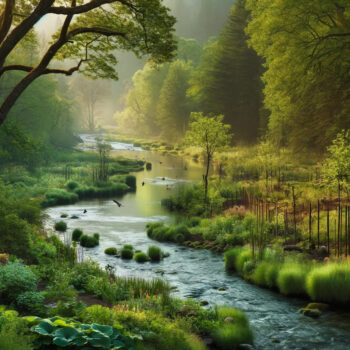By Oliva Wilson
Staff writer for Wake Up World
Riparian planting is a cornerstone of sustainable land management and permaculture design. It aims to repair the ecological harm inflicted by human activity. This practice is vital for anyone owning a property with waterways or those involved in broader restoration projects. It plays a crucial role in restoring the natural state of riverbanks and enhancing the overall health of river ecosystems.
Understanding Riparian Planting
The Importance of Native Vegetation
[pro_ad_display_adzone id=”110028″]
Riverbanks often suffer from degradation due to various human activities such as deforestation and overgrazing. This damage typically results in the loss of native riparian vegetation, which is essential for maintaining the ecological balance of river ecosystems. Restoring these areas involves reintroducing native trees and plants that have been lost, which is critical for improving water quality, managing flood risks, and boosting biodiversity.
Regulating Water Temperatures
Strategically planting trees and shrubs along riverbanks can significantly reduce water temperatures. This cooling effect is vital for maintaining the health of aquatic ecosystems. The shade from these plants helps keep the water at optimal temperatures, which is essential for supporting a diverse range of aquatic species.
Choosing the Right Plants for Riparian Restoration
Selecting the appropriate mix of riparian vegetation is a nuanced process that requires a deep understanding of the area’s specific environmental conditions and native species. This tailored approach is crucial for ensuring that restoration efforts are both effective and sustainable.
Assessing Environmental Conditions
The first step in choosing the right plants involves assessing the local climate, soil types, water availability, and existing vegetation. Factors such as soil pH, moisture levels, and sun exposure must be taken into account to select species that will thrive in their natural habitats without extensive maintenance.
Understanding Local Flora
It is also essential to have an understanding of the local flora. This includes not only the currently present species but also those that historically thrived in the area. Consulting with local botanists, utilizing regional plant databases, and reviewing historical ecological surveys can provide valuable insights into species best suited for restoration projects.
Tailoring Plant Selections
Once the environmental assessments are complete, the next step is to tailor plant selections to fit the specific needs of the riverbank. This involves choosing a variety of species that can fulfill different ecological roles. For example, deep-rooted trees and shrubs can help stabilize soil and manage erosion, while flowering plants can support pollinators and increase biodiversity.
Integrating Plant Functions
Each selected plant species should serve multiple functions within the riparian buffer. For instance, some plants might be chosen for their ability to filter pollutants from runoff, while others are selected for their robust root systems that can prevent soil erosion. The aesthetic value of flowering plants can also play a role in community engagement and educational outreach.
Continuous Monitoring and Adaptation
Finally, successful riparian planting requires continuous monitoring and adaptation. This includes regular evaluations of plant health and growth, adjustments based on ecological changes, and replacing non-thriving species with more suitable ones. This dynamic approach helps ensure that the riparian buffer remains resilient against environmental changes and continues to support a diverse ecosystem.
By carefully considering these factors, restoration efforts can be effectively aligned with the natural dynamics of the ecosystem, leading to a healthier and more sustainable river environment.
The Role of Riparian Buffer Zones
Creating Protected Areas
Riparian buffer zones are critical areas established along the banks of rivers and streams to protect them from adverse human activities. These zones are typically free from overgrazing, traffic, and heavy machinery, allowing the natural ecosystem to thrive without human interference.
Benefits of Buffer Zones
Riparian buffers serve as vital corridors for wildlife movement and biodiversity conservation by setting aside areas for wildlife within landscapes dominated by human activity. These zones can include various habitats, such as forests, woodlands, wet meadows, and other wetland areas, providing sanctuary for various species.
Natural Regeneration
In some cases, active planting might not be necessary. Simply protecting an area from human and livestock intrusion can allow native vegetation to regenerate naturally. This process helps restore ecological balance over time, with minimal human intervention.
Re-Introductions in Riparian Restoration
Adjusting Riverbank Structures
Modifying the physical structure of riverbanks, such as altering slopes or contours, can help reduce erosion and manage the flow of water. These technical adjustments are crucial in creating stable environments that support diverse aquatic and terrestrial life.
Expert Involvement
Given the complexity of riparian restoration, involving experts in the planning and implementation phases is essential. This approach ensures that the interventions are scientifically sound and that they effectively contribute to the long-term health of the river ecosystems.
Conclusion: A Call to Action for Riparian Restoration
Riparian planting restores damaged riverbanks and rejuvenates entire ecosystems, supporting biodiversity and providing resilience against environmental changes. By embracing these practices, property owners and conservationists can be pivotal in advancing sustainable land management and contributing to a healthier planet.
About the Author
Olivia Wilson is a passionate writer with a green thumb and a heart for healthy living. Through her articles, she aims to inspire others to cultivate vibrant gardens and nourish their bodies and souls through the power of nature. When she’s not tending to her garden or experimenting with new recipes in the kitchen, she can be found exploring local farmers’ markets or enjoying a peaceful hike in the great outdoors.
[pro_ad_display_adzone id=”110027″]







